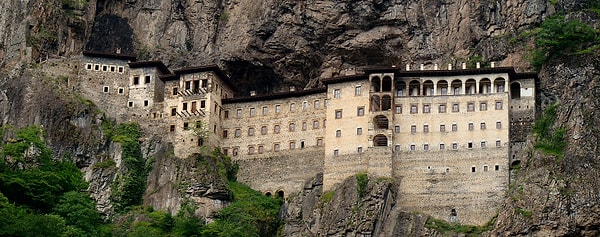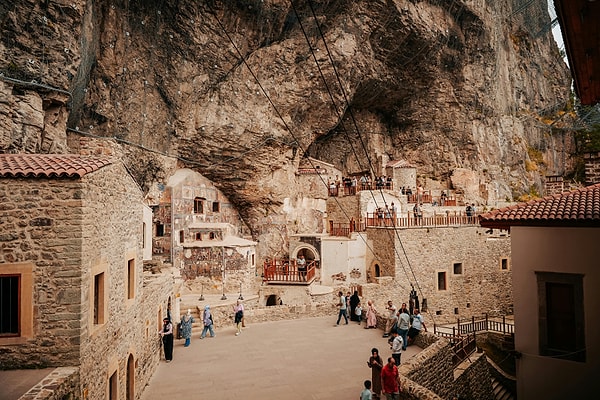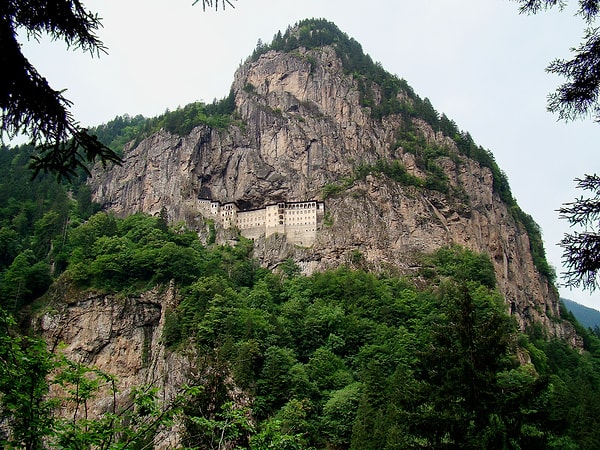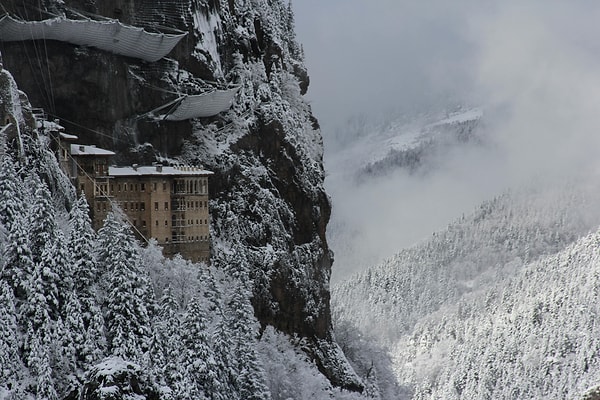Visiting Sumela Monastery in Trabzon: A Must-See Religious Landmark
Among the steep mountains of the Black Sea, there is a structure rising on the slope of the rocks that takes on a mystical silence: Sumela Monastery. This monastery, which has been loaded with great meanings in terms of both faith and art for centuries, is an unforgettable stop for those who want to experience the history and nature of Trabzon together. For those who are thinking of visiting, we have brought together the story of Sumela Monastery from past to present, transportation routes, architectural features and all the curious details in this guide.
History of Sumela Monastery: A 1600-Year Legend

Foundation Period and Legendary Beginning
According to historical sources, it is rumoured that it was founded in 386 AD by two Athenian monks, Barnabas and Sophronios, during the reign of Byzantine Emperor Theodosius I. It is thought that the structures that formed the basis of the monastery were caves carved by monks for worship at that time. This simple structure grew over time and became an impressive complex.
Byzantine and Komnenos Period
Especially in the 6th century, the monastery underwent a major restoration by General Belisarios on the orders of the Byzantine Emperor Justinian and then became an important religious centre during the reign of the Komnenos of Trabzon. During the reign of Alexios III (1349-1390), the monastery was granted great privileges and was supported and enriched by his son Manuel III.
Ottoman Period and Protection
With the Ottoman conquest of Trabzon in 1461, Sumela Monastery came under Ottoman rule. However, the Ottomans respected the religious importance of the monastery and did not interfere with the religious life here; they even granted rights to the monastery with various edicts. In this way, Sumela continued to exist as an active monastery during the Ottoman period.
Republican Period and Abandonment
As a result of the Turkish-Greek population exchange in 1923, the Orthodox priests migrated to Greece and the monastery was completely abandoned. A major fire in 1930 destroyed most of the interior structure. The monastery, which was left to its fate for many years, was opened to tourism in 1962 and declared a first-degree archaeological site in 1972.
Restoration Process and Re-Opening
The extensive restoration work that began in 2015 was of great importance for both the safety of the structure and the preservation of the frescoes. After the stabilisation of the rocks, roof repairs and fresco cleaning were completed, it was reopened to visitors in 2019.
Architectural Structure and Artistic Values of Sumela Monastery

This unique structure built on a high rocky cliff offers a large complex including a cave church, chapels, monks' rooms, visitors' rooms, a library, an ayazma and various service areas.
The rock church in the centre of the monastery is decorated with impressive frescoes. These frescoes, both on the interior and exterior facades, depict Jesus Christ, the Virgin Mary, saints, angels and apocalyptic scenes. Many of the frescoes are dated to the reign of Alexios III. The 18th-century frescoes are located on the facades and offer a visually fascinating atmosphere.
Does Anyone Live in Sumela Monastery?

Sumela Monastery is not home to any religious community today. The monastery, which was abandoned after the exchange in 1923, was converted to museum status in 1986, thus becoming a cultural and tourism area open only to visitors.
However, every year on 15 August, on the feast of the Assumption of the Virgin Mary, which is considered sacred for the Orthodox, a special service is allowed to be held with a limited number of visitors. Special permission must be obtained from the Turkish Ministry of Culture and Tourism and the Greek Patriarchate of Fener.
How to Get to Sumela Monastery?

Transportation Information
The first stop for transportation to Sumela Monastery, which is 48 km from Trabzon city centre, is the Maçka district.
It is possible to get from Trabzon to Maçka by minibuses. After Maçka, you can continue by minibus, taxi or private car until the entrance of Altındere National Park.
There is a car park for visitors travelling by private car. The road from the car park to the monastery is approximately 3-4 km. This distance can be completed on foot in 45-60 minutes. Alternatively, paid minibus services are also available.
Entrance Fee and Visiting Hours to Sumela Monastery
Entrance Fee: 20 Euro. The MuseumPass is Valid.
Visiting Hours: It is generally open to visitors between 09:00-19:00 in summer and 09:00-17:00 in winter. Since it may be closed on Mondays, the current hours should be checked.
Why is Sumela Monastery so famous?

Natural Beauties and Landscape: Located on a steep cliff in the lush nature of the Black Sea, the monastery fascinates its visitors both visually and spiritually.
Historical Depth: With more than 1600 years of history, it bears the traces of many periods from the Byzantine to the Ottoman.
Architectural Wonder: With its complex structure carved into the rocks, it is among the most interesting religious structures in the world.
Cultural and Spiritual Value: It is still a respected centre with its Panagia icon and its place in the Orthodox world.
With these aspects, Sumela Monastery has a unique place among Turkey's cultural heritage. It is an indispensable point of visit for both local and foreign tourists.
Is Sumela Monastery Worth Visiting?

Yes, it is definitely worth it!
Sumela Monastery offers an experience, not just a structure. It is an ideal destination for anyone who wants to experience history, nature, culture and mysticism at the same time. Moreover, it can create a cultural route together with other structures such as Altındere National Park, Vazelon and Kuştul Monasteries.
Keşfet ile ziyaret ettiğin tüm kategorileri tek akışta gör!

Send Comment